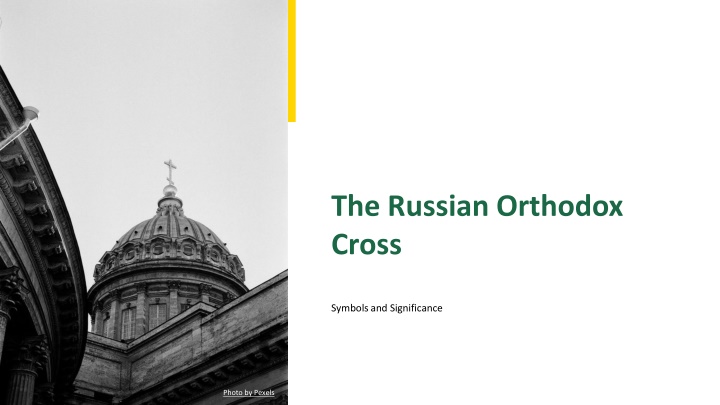
Russian Orthodox Cross: Symbols, Significance & Cultural Heritage
Uncover the unique design elements and cultural significance of the Russian Orthodox cross, symbolizing faith, sacrifice, and historical resilience. Explore its intricate layers of meaning within the context of Russian art, literature, and worship practices.
Download Presentation

Please find below an Image/Link to download the presentation.
The content on the website is provided AS IS for your information and personal use only. It may not be sold, licensed, or shared on other websites without obtaining consent from the author. If you encounter any issues during the download, it is possible that the publisher has removed the file from their server.
You are allowed to download the files provided on this website for personal or commercial use, subject to the condition that they are used lawfully. All files are the property of their respective owners.
The content on the website is provided AS IS for your information and personal use only. It may not be sold, licensed, or shared on other websites without obtaining consent from the author.
E N D
Presentation Transcript
The Russian Orthodox Cross Symbols and Significance Photo by Pexels
01 Introduction to the Cross Table of Contents 02 Design Elements 03 The Slanted Beam 04 Cultural Significance 05 Historical Development 06 Cross in Worship 07 The Cross and Iconography 08 Contemporary Relevance 09 Comparative Analysis 10 Personal Reflection 11 Conclusion
1 Introduction to the Cross Symbol of Faith The cross is a profound symbol in Christianity, representing Christ's sacrifice and victory over sin. In the Russian Orthodox tradition, the cross takes on unique features that convey deeper meanings. Understanding the design and its elements gives insights into its spiritual significance. This presentation explores the unique aspects of the Russian Orthodox cross. Photo by Pexels
2 Design Elements Three Crossbeams The Russian Orthodox cross is distinctive for its three horizontalcrossbeams. Each beam has a particular significance, enhancing its religious meaning. The top beam represents the inscription written on the cross by Pontius Pilate. The middle beam is where Christ s hands were nailed, reflecting His suffering. Photo by Pexels
3 The Slanted Beam A Deep Symbol The lower crossbeam is uniquely slanted downward, symbolizing the path to Heaven. This slant emphasizes the journey of sinners toward redemption and grace. It serves as a reminder of God s mercy and the hope of salvation. This element is crucial in understanding the Orthodox faith's perspective on sin. Photo by Pexels
4 Cultural Significance Beyond Religion The Russian Orthodox cross transcends religious boundaries, embodying cultural identity. In Russian art, literature, and architecture, the cross is a prominent motif. It represents resilience and continuity of faith through historical upheavals. Understanding its cultural significance enriches appreciation for Russian heritage. Photo by Pexels
5 Historical Development Evolution of the Symbol The shape of the Russian Orthodox cross evolved over centuries, influenced by various factors. It reflects the synthetical process of Byzantine and indigenous traditions. The cross became more prominent during the Mongol invasion and the rise of Moscow. Examining history reveals the cross's adaptability and enduringsignificance. Photo by Pexels
6 Cross in Worship A Sacred Tool In Russian Orthodox worship, the cross is a central element of liturgical practices. It is used in blessings, processions, and various sacraments. The faithful venerate the cross as a powerful instrument of faith and hope. Its presence during worship signifies the core beliefs unified by this symbol. Photo by Pexels
7 The Cross and Iconography Artistic Representation Icons of the Russian Orthodox cross often feature rich symbolism and artistry. Each representation tells a story, linking the cross to specific saints and events. This artistic expression deepens the understanding of its religious significance. Exploring cross iconography reveals spiritual narratives woven throughart. Photo by Pexels
8 Contemporary Relevance Modern Interpretations Today, the Russian Orthodox cross remains relevant in modern society and spirituality. It serves not only as a religious symbol but also as a cultural emblem. Many Russians express their faith through this symbol in daily life. Recognizing contemporary relevance highlights its continuing journeythroughtime. Photo by Pexels
9 Comparative Analysis Crosses Worldwide Comparing the Russian Orthodox cross with others enriches understanding of symbolism. Different Christian denominations have varied representations of the cross. Identifying similarities and differences reveals diverse theological perspectives. Crosses function as a bridge connecting believers across cultures. Photo by Pexels
10 Personal Reflection Inviting Engagement How does the Russian Orthodox cross resonate with your own beliefs and experiences? Reflecting on personal connections can deepen spiritual insight. Engaging with the cross encourages dialogue about faith and identity. It's an invitation to explore and understand one's spiritual journey. Photo by Pexels
11 Conclusion Final Thoughts The Russian Orthodox cross is a multifaceted symbol with deep faith-rootedsignificance. Its design, cultural relevance, and historical evolution contribute to its richness. Understanding this symbol fosters greater appreciation for Orthodox spirituality. Thank you for exploring the Russian Orthodox cross with us today! Photo by Pexels
